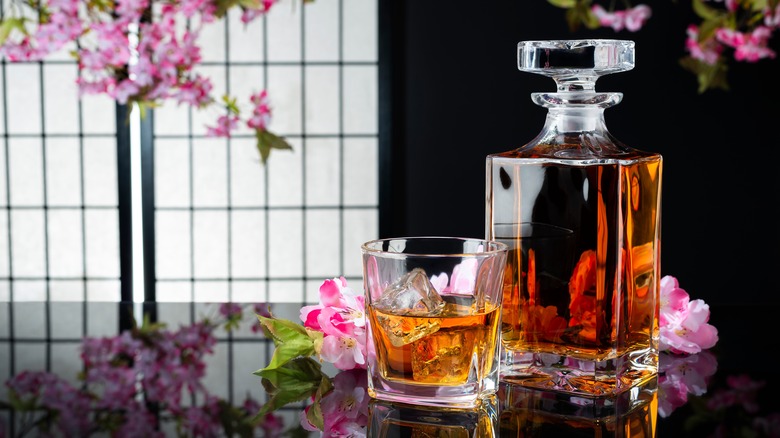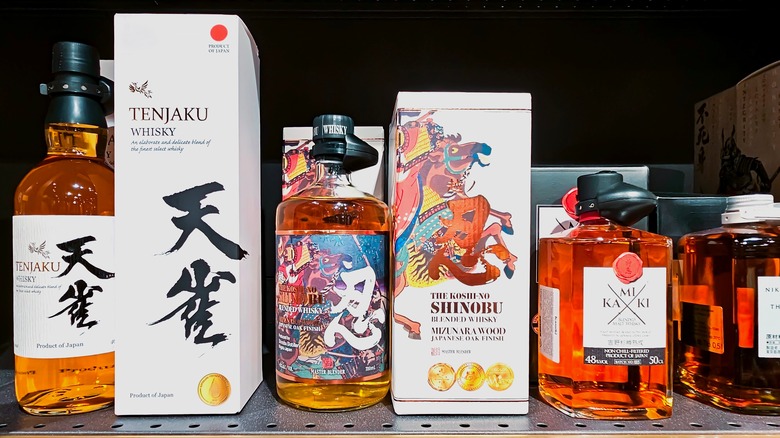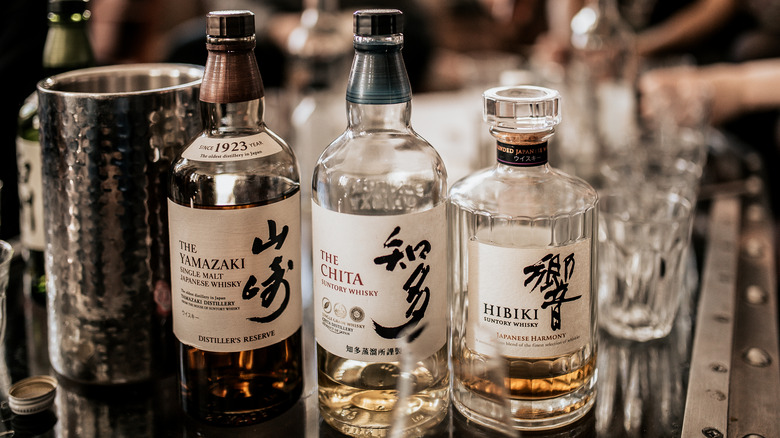What Sets Japanese Whisky Apart From Its American Counterpart
At its most basic, whisky is a spirit distilled from grains (usually barley, corn, rye, or wheat) and aged in wood barrels. But its styles vary hugely depending on where it's from and how it's produced, even within the same country. For example, think of American whiskey, and bourbon, rye, corn, or Tennessee styles may come to mind. When it comes to Scotch whisky, there's single malt, blended malt, single grain, and blended grain, with key differences popping up between Scotland's many whisky regions. On the other hand, Irish whiskeys include malt, grain, pot still, and blended varieties.
But what about Japanese whisky? How does that compare? It may not have the long history dating back hundreds of years that Scotch whisky or American or Irish whiskey boast, but it's not exactly new, either. Japanese whisky production began in the 19th century, around 1870, and became a commercial enterprise in 1923.
It wasn't really until the early 21st century, though, that Japanese whisky suddenly seemed to boom in the U.S. and beyond, becoming highly sought-after internationally. And while the American and Japanese spirits have some things in common, they can also be very different in terms of style, production method, and taste.
Japanese whisky is closer to Scotch than American styles
The difference between whisky and whiskey is about more than just mere spelling. In many ways, Japanese whisky is more similar to Scotch than it is to American styles of the spirit. That is largely due to the fact that whisky-making skills and knowledge were taken from Speyside and other Scottish regions back to Japan back in the 1920s, with both Japanese and Scotch whiskies following the same double distillation process.
Japan often even imports ingredients, such as barley, from Scotland. So it's not entirely surprising that, when it comes to flavor, Japanese whiskies tend to have more in common with those from Scotland than with those from America, often tasting more peaty and smoky, for example, and less sweet than bourbon or rye.
But that doesn't mean we can simply think of Japanese whisky as the same Scotch. Protected by Geographical Indications status, only whisky made in Scotland can be called Scotch. And, just like spirits from other countries, Japanese whisky is very much its own thing, with lots of complex subtleties and variations depending on the individual production styles.
American whiskey has history – but Japan is developing new traditions
While American whiskey and Scotch have had hundreds of years to evolve and develop consistency, Japanese whisky is a relative newcomer, having only been sold commercially for around a century. Whether made by bigger companies such as Suntory and Nikka, or via smaller independent distilleries, Japanese whisky production has experimented and innovated to create a distinctive array of spirits in this shorter time period.
Partly, this comes down to local geography and environmental influences. Different cask options for aging Japanese whisky include mizunara, or Japanese oak, which gives it a unique flavor profile you won't find in an American spirit. The Yamazaki Distillery uses water from the mountains near Tokyo in the distillation process. And the huge variation in climate, altitude, and temperature across Japan means different aging times as well as location-specific flavors.
American whiskeys have several hard-and-fast, legally-defined rules; for example, bourbon must be made from a minimum 51% corn; rye whiskey from at least 51% rye; and corn whiskey from at least 80% corn. Until recent years, the rules around labeling Japanese whisky have been much more fluid, although in 2021 Japan Spirits & Liqueurs Makers Association issued guidelines on what can be called Japanese whisky. But while the spirit might be in its infancy when compared with American styles, it can hold its own in terms of quality. In 2020, a Japanese whisky was named the world's best single malt at the World Whisky Awards.



